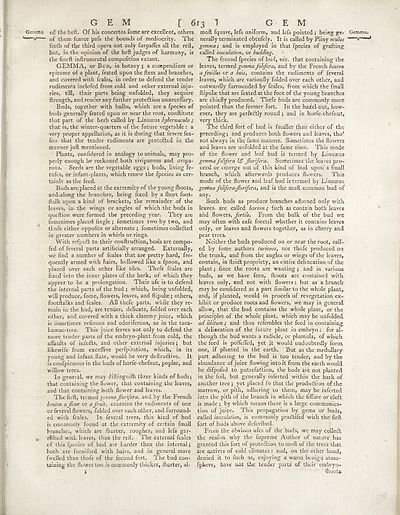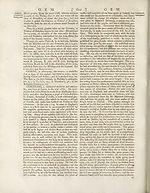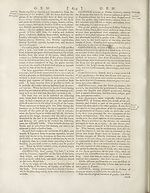Encyclopaedia Britannica > Volume 7, ETM-GOA
(661) Page 613
Download files
Complete book:
Individual page:
Thumbnail gallery: Grid view | List view

GEM [ 613 1 GEM
Gemma ed the beft. Of his concertos fome are excellent, others moft fquare, lefs uniform, and lefs pointed ; being ge-
V of them fcarce pafs the bounds of mediocrity. The nerally terminated obtufely. It is called by Pliny oculus
fixth of the third opera not only furpaffes all the reft, gemma; and is employed in that fpecies of grafting
but, in the opinion of the beft judges of harmony, is called inoculation, or budding.
the fineft inftrumental compofition extant. The fecond fpecies of bud, viz. that containing the
GEMMA, or Bud, in botany ; a compendium or leaves, termed gemma folifera, and by the Yrench. bouton
epitome of a plant, feated upon the item and branches, a feuillts or a bsis, contains the rudiments of feveral
and covered with fcales, in order to defend the tender leaves, which are varioufly folded over each other, and
rudiments inclofed from cold and other external inju- outwardly furrounded by fcales, from which the fmall
ries, till, their parts being unfolded, they acquire ftipulae that are feated at the foot of the young branches
ftrength, and render any further proteftion unneceffary. are chiefly produced. Thefe buds are commonly more
Buds, together with bulbs, which are a fpecies ef pointed than the former fort. In the ha2;el-nut, how-
buds generally feated upon or near the root, conftitute ever, they are perfeftly round ; and in horfe-chefnut,
that part of the herb called by Linnaeus hybernacula; very thick.
that is, the winter-quarters of the future vegetable : a The third fort of bud is fmaller than either of the
very proper appellation, as it is during that fevere fea- preceding; and produces both flowers and leaves, tho*
fon that the tender rudiments are prote&ed in the not always in the fame manner. Sometimes the flowers
manner juft mentioned. and leaves are unfolded at the fame time. This mode
Plants, confidered in analogy to animals, may pro- of the flower and leaf bud is termed by Linnaeus
perly enough be reckoned both viviparous and ovipa- gemma folifera & Jlorifera. Sometimes the leaves pro-
rous. Seeds are the vegetable eggs ; buds, living fe- ceed or emerge out of this kind of bud upon' a fmall
tufes, or infant-plants, which renew the fpecies as cer- branch, which afterwards produces flowers. This
tainlv as the feed. mode of the flower and leaf bud is termed by Linnaeus
Buds are placed at the extremity of the young flioots, gettima folifera-jlorifera, and is the moft common bud of
and.along the branches, being fixed by a ftiort foot- any.
ftalk upon a kind of brackets, the remainder of the Such buds as produce branches adorned only with
leaves, in- the wings or angles of which the buds in leaves, are called barren; fuch as contain both leaves
queftion were formed the preceding year. They are and flowers, fertile. From the bulk of the bud wc
fometimes placed Angle ; fometimes two by two, and may often with eafe foretel whether it contains leaves
thofe either oppofite or alternate ; fometimes colledted only, or leaves and flowers together, as in cherry and
in greater numbers in whirls or rings. pear trees.
With refpeft to their conftrudtion, buds are compo- Neither the buds produced on or near the root, call-
fed of feveral parts artificially arranged. Externally, ed by fome authors turiones, nor thofe produced on
we find a number of fcales that are pretty hard, fre- the trunk, and from the angles or wings of the leaves,
quently armed with hairs, hollowed like a fpoon, and contain, in ftrict propriety, an entire delineation of the
placed over each other like tiles. Thefe fcales are plant; fince the roots are wanting; and in various
fixed into the inner plates of the bark, of which they buds, as we have feen, flioots are contained with
appear to be a prolongation. Their ufe is to defend leaves only, and not with flowers: but as a branch
the internal parts of the bud ; which, being unfolded, may be confidered as a part fimilar to the whole plant,
will produce, fome, flowers, leaves, and ftipulas; others, and, if planted, would in procefs of revegetation ex-
footftalks and fcales. All thefe parts, while they re- hibit or produce roots and flowers, we may in general
main in the bud, are tender, delicate, folded over each allow, that the bud contains the whole plant, or the
other, and covered with a thick clammy juice, which principles of the whole plant, which may be unfolded
is fometimes refinous and odoriferous, as in the taca- ad libitum; and thus refembles the feed in containing,
hamac-tree. This juice ferves not only to defend the a deliaeation of the future plant in embryo: for al-
more tender parts of the embryo-plant from cold, the though the bud wants a radicle, or plumula, of which
afiaults of infe&s, and other external injuries; but the feed is poffeffed, yet jt would undoubtedly form
likewife from exceffive perfpiration, which, in its one, if planted in the earth. But as the medullary
young and infant ftate, would be very deftru&ive. It part adhering to the bud is too tender, and by the
is confpicuous in the buds of horfe-chefnut, poplar, and abundance of juice flowing into it from the earth would
willow trees. be difpofed to putrefa&ion, the buds are not planted
In general, we may diftinguifh three kinds of buds; in the foil, but generally inferted within the bark of
that containing the flower, that containing the leaves, another tree ; yet placed fo that the production of the
and that containing both flower and leaves. marrow, or pith, adhering to them, may be inferted
The firft, termed gemma Jlorifera, and by the French into the pith of the branch in which the fiffure or cleft
bouton a Jleur or a fruit, contains the rudiments of one is made ; by which means there is a large communica-
or feveral flowers, folded over each other, and furround- tion of juice. This propagation by gems or buds,
ed with fcales. In feveral trees, this kind of bud called inoculation, is commonly pradtifed with the firft
is commonly found at the extremity of certain fmall fort of buds above defcribed.
branches, which are ftrorter, rougher, and lefs gar- From the obvious ufes of the buds, we may colledt
4 infhed with leaves, than the reft. The external fcales the reafon why the fupreme Author of nature has
of this fpecies of bud are harder than the internal; granted this fort of protection to moft of the trees that
both are furnilhed with hairs, and in general more are natives of cold climates: and, on the other hand,
fwelled than thofe of the fecond fort. The bud con- denied it to fuch as, enjoying a warm benign atmo-
tainiug the flower too is commonly thicker, Ihorter, al- fphere, have not the tender parts of their embryo-
1 fliootjt
Gemma ed the beft. Of his concertos fome are excellent, others moft fquare, lefs uniform, and lefs pointed ; being ge-
V of them fcarce pafs the bounds of mediocrity. The nerally terminated obtufely. It is called by Pliny oculus
fixth of the third opera not only furpaffes all the reft, gemma; and is employed in that fpecies of grafting
but, in the opinion of the beft judges of harmony, is called inoculation, or budding.
the fineft inftrumental compofition extant. The fecond fpecies of bud, viz. that containing the
GEMMA, or Bud, in botany ; a compendium or leaves, termed gemma folifera, and by the Yrench. bouton
epitome of a plant, feated upon the item and branches, a feuillts or a bsis, contains the rudiments of feveral
and covered with fcales, in order to defend the tender leaves, which are varioufly folded over each other, and
rudiments inclofed from cold and other external inju- outwardly furrounded by fcales, from which the fmall
ries, till, their parts being unfolded, they acquire ftipulae that are feated at the foot of the young branches
ftrength, and render any further proteftion unneceffary. are chiefly produced. Thefe buds are commonly more
Buds, together with bulbs, which are a fpecies ef pointed than the former fort. In the ha2;el-nut, how-
buds generally feated upon or near the root, conftitute ever, they are perfeftly round ; and in horfe-chefnut,
that part of the herb called by Linnaeus hybernacula; very thick.
that is, the winter-quarters of the future vegetable : a The third fort of bud is fmaller than either of the
very proper appellation, as it is during that fevere fea- preceding; and produces both flowers and leaves, tho*
fon that the tender rudiments are prote&ed in the not always in the fame manner. Sometimes the flowers
manner juft mentioned. and leaves are unfolded at the fame time. This mode
Plants, confidered in analogy to animals, may pro- of the flower and leaf bud is termed by Linnaeus
perly enough be reckoned both viviparous and ovipa- gemma folifera & Jlorifera. Sometimes the leaves pro-
rous. Seeds are the vegetable eggs ; buds, living fe- ceed or emerge out of this kind of bud upon' a fmall
tufes, or infant-plants, which renew the fpecies as cer- branch, which afterwards produces flowers. This
tainlv as the feed. mode of the flower and leaf bud is termed by Linnaeus
Buds are placed at the extremity of the young flioots, gettima folifera-jlorifera, and is the moft common bud of
and.along the branches, being fixed by a ftiort foot- any.
ftalk upon a kind of brackets, the remainder of the Such buds as produce branches adorned only with
leaves, in- the wings or angles of which the buds in leaves, are called barren; fuch as contain both leaves
queftion were formed the preceding year. They are and flowers, fertile. From the bulk of the bud wc
fometimes placed Angle ; fometimes two by two, and may often with eafe foretel whether it contains leaves
thofe either oppofite or alternate ; fometimes colledted only, or leaves and flowers together, as in cherry and
in greater numbers in whirls or rings. pear trees.
With refpeft to their conftrudtion, buds are compo- Neither the buds produced on or near the root, call-
fed of feveral parts artificially arranged. Externally, ed by fome authors turiones, nor thofe produced on
we find a number of fcales that are pretty hard, fre- the trunk, and from the angles or wings of the leaves,
quently armed with hairs, hollowed like a fpoon, and contain, in ftrict propriety, an entire delineation of the
placed over each other like tiles. Thefe fcales are plant; fince the roots are wanting; and in various
fixed into the inner plates of the bark, of which they buds, as we have feen, flioots are contained with
appear to be a prolongation. Their ufe is to defend leaves only, and not with flowers: but as a branch
the internal parts of the bud ; which, being unfolded, may be confidered as a part fimilar to the whole plant,
will produce, fome, flowers, leaves, and ftipulas; others, and, if planted, would in procefs of revegetation ex-
footftalks and fcales. All thefe parts, while they re- hibit or produce roots and flowers, we may in general
main in the bud, are tender, delicate, folded over each allow, that the bud contains the whole plant, or the
other, and covered with a thick clammy juice, which principles of the whole plant, which may be unfolded
is fometimes refinous and odoriferous, as in the taca- ad libitum; and thus refembles the feed in containing,
hamac-tree. This juice ferves not only to defend the a deliaeation of the future plant in embryo: for al-
more tender parts of the embryo-plant from cold, the though the bud wants a radicle, or plumula, of which
afiaults of infe&s, and other external injuries; but the feed is poffeffed, yet jt would undoubtedly form
likewife from exceffive perfpiration, which, in its one, if planted in the earth. But as the medullary
young and infant ftate, would be very deftru&ive. It part adhering to the bud is too tender, and by the
is confpicuous in the buds of horfe-chefnut, poplar, and abundance of juice flowing into it from the earth would
willow trees. be difpofed to putrefa&ion, the buds are not planted
In general, we may diftinguifh three kinds of buds; in the foil, but generally inferted within the bark of
that containing the flower, that containing the leaves, another tree ; yet placed fo that the production of the
and that containing both flower and leaves. marrow, or pith, adhering to them, may be inferted
The firft, termed gemma Jlorifera, and by the French into the pith of the branch in which the fiffure or cleft
bouton a Jleur or a fruit, contains the rudiments of one is made ; by which means there is a large communica-
or feveral flowers, folded over each other, and furround- tion of juice. This propagation by gems or buds,
ed with fcales. In feveral trees, this kind of bud called inoculation, is commonly pradtifed with the firft
is commonly found at the extremity of certain fmall fort of buds above defcribed.
branches, which are ftrorter, rougher, and lefs gar- From the obvious ufes of the buds, we may colledt
4 infhed with leaves, than the reft. The external fcales the reafon why the fupreme Author of nature has
of this fpecies of bud are harder than the internal; granted this fort of protection to moft of the trees that
both are furnilhed with hairs, and in general more are natives of cold climates: and, on the other hand,
fwelled than thofe of the fecond fort. The bud con- denied it to fuch as, enjoying a warm benign atmo-
tainiug the flower too is commonly thicker, Ihorter, al- fphere, have not the tender parts of their embryo-
1 fliootjt
Set display mode to:
![]() Universal Viewer |
Universal Viewer | ![]() Mirador |
Large image | Transcription
Mirador |
Large image | Transcription
Images and transcriptions on this page, including medium image downloads, may be used under the Creative Commons Attribution 4.0 International Licence unless otherwise stated. ![]()
| Encyclopaedia Britannica > Encyclopaedia Britannica > Volume 7, ETM-GOA > (661) Page 613 |
|---|
| Permanent URL | https://digital.nls.uk/189129822 |
|---|
| Attribution and copyright: |
|
|---|
| Description | Ten editions of 'Encyclopaedia Britannica', issued from 1768-1903, in 231 volumes. Originally issued in 100 weekly parts (3 volumes) between 1768 and 1771 by publishers: Colin Macfarquhar and Andrew Bell (Edinburgh); editor: William Smellie: engraver: Andrew Bell. Expanded editions in the 19th century featured more volumes and contributions from leading experts in their fields. Managed and published in Edinburgh up to the 9th edition (25 volumes, from 1875-1889); the 10th edition (1902-1903) re-issued the 9th edition, with 11 supplementary volumes. |
|---|---|
| Additional NLS resources: |
|

